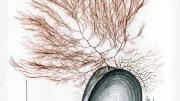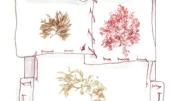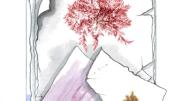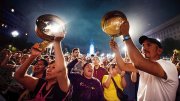In a time well before the island of Martha’s Vineyard, Massachusetts, became a mecca for celebrity spotters, Mary A. Robinson kept an eye out along its coastline for seaweed and marine algae. She gathered interesting specimens, dried, pressed, and mounted them, and in 1885 formed a scrapbook of 75 plates ranging in size from two by three inches to six by nine inches. Some plates consist solely of a botanical specimen, but in other cases, Robinson embellished flora fished from the sea with her watercolor paintings of lighthouses, sailboats, and other salty subjects. She was an artist, not a phycologist, and although she was able to identify many of her specimens—perhaps with help from one or another expert resident on the island—she evidently knew the names of none of the examples shown on this page. But she saw their beauty.
Mrs. Constance Neelon of Southern Pines, North Carolina, gave Robinson’s scrapbook to Harvard’s Farlow Herbarium in 2002. “We were thrilled to get it,” says archives librarian Lisa DeCesare. “It chronicles local flora, and it is beautiful. We have other seaweed scrapbooks, including a small one bound in whale bone, but the illustrations on some of Robinson’s plates make this a real winner.” (For the scrapbook in its entirety, and more, go to www.huh.harvard.edu/libraries/Robinson_exhibit/robinson.htm.)
How did Mrs. Neelon get the scrapbook? Her family summered on the Vineyard, and around 1950 her husband found the scrapbook in the attic of an old farmhouse he bought and restored on Lambert’s Cove in West Tisbury. The house had been in the Norton family.
How did the scrapbook come to be in that attic? Mary Robinson was born in Montreal, Canada, in 1826. Her maiden name is unknown. She married Samuel D. Robinson, born in Sligo, Ireland, and 10 years her junior. They later lived on the Vineyard—in Cottage City, now Oak Bluffs—at least most of the year, perhaps spending the coldest months in Providence, Rhode Island, where Samuel died in 1885. Mary is listed in an 1897 Cottage City directory as proprietor of a boarding house on the corner of Tuckernuck Street and what is now Circuit Avenue. When she died in 1898, a sale of her personal effects and the boarding house failed to raise sufficient funds to cover claims against her estate. One of these was a bill for $19.45 for medicine from James G. Norton. Perhaps Norton took the scrapbook in settlement of that debt.












